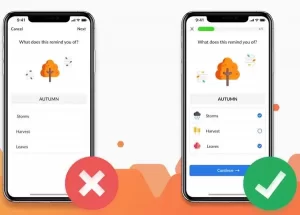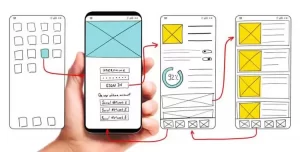What is UX(User Experience) design? Its importance and a few useful points
User experience or UX is a popular term in today’s technology and design industry. However, many people do not know the meaning of UX or how to use the term correctly.
In this article, we will take a closer look at UX and answer the following questions:
- What is UX?
- What is UX design?
- What is the importance of UX?
- What does a UX designer do?
What is UX?(User Experience)
Let’s start with the definition of UX, which stands for user experience. When talking about user experience, we refer to how people interact with a product. For example, we connect with a power switch when we want to turn on our room lights. The design of this key – including color, material, and appearance – may affect how we feel about this interaction.
Similarly, in digital design, UX refers to anything that affects the user interaction with a digital product. When people use a product, they evaluate their experiences according to the following criteria:
- Value. Is this product valuable to me?
- Function. Does it work?
- Usability. Is it easy to use?
- General impression. Is it pleasant to use?

Origin and Objectives of UX
Don Norman, the founder of the Nielsen Norman Group, coined the term user experience in the 1990s. According to Norman, “The user experience encompasses all aspects of the end-user interaction with the company, its services, and products.
Other essentials to know about UX include:
user experience refers to what users think and feel. Humans are rational and emotional, and both play an important role in users’ perceptions of a product.
User experience also depends on the context in which the product is used. To design a great product, you need to understand the field well. It is also important to understand a product’s role in users’ lives.
User experience concerning your product may change over time. When people start using a new product, they may have different feelings about it, and the more they become familiar with it, the more they may change their minds.
In the next section, we will focus on these three points

What is UX design?
UX is almost always followed by the word design. By the nature of the term, the people working in this field are UX designers.
Does this mean that UX designers are the people who design the user experience? The answer is no. The user experience cannot be designed because it refers to the user’s perception of the product. But it is possible to create conditions that lead to positive feelings and perceptions. So, you can say that UX designers are people who design for UX.
In simpler terms, UX design is the process of producing products (digital or physical) that are functional and usable:
- Usable: Using a product should be simple and easy.
- Useful: A product should meet your needs. If this product does not fill the gap in users’ lives, there is no real reason to use it.
- Optimal: The product’s appearance should be attractive and evoke positive emotions.
- Detectable: If the user has a problem with a product, he should be able to find a solution quickly.
- Accessible: The product or service should be available to everyone, including the non-disabled.
- Valid: The company and its products must be reliable.

Here are five things to keep in mind when defining a UX design:
1. UX design is beyond usability or usability
The practicality of designing a product helps us understand if users can do their jobs efficiently and effectively. Good UX is impossible without proper use. However, usability is only one of the good features of UX.
Usability helps us produce products with good performance, but easy use of a product does not guarantee that people will use it.
2- UX design is different from UI design
UX design is often called UI (user interface) design. Although the user interface is an important part of the user experience, it is a surface layer of a product.
UX designers think beyond the surface layer when designing the performance of their product and make the connection between appearance and how it works. The image below shows how UX covers many different aspects of product design, including UI design:
3-UX design communicates and interacts with people
“If you do not understand people, you cannot understand good design.”
Simply put, UX requires a deep understanding of the user: the needs, wants, behaviors, and context of using a product. The ability to interact and understand user needs is critical for UX designers.
4- UX design is a continuous and evolving process
With new user feedback, the UX design of a product will also improve, and as product and industry requirements change, you may need to update your design to meet new needs. A notable example is a competition between Nokia and Apple in the mobile device market. Nokia has long been a leader in the industry, but users’ expectations for mobile interactions changed when the first iPhone hit the market. Nokia failed to meet the new requirements, and Apple quickly outgrew it.
5. UX design should take into account business needs
Offering a product that people love alone is useless. Your product should pursue business goals. For this reason, product developers need to consider both their users’ and business goals. Creating a balance between the two and providing useful and practical solutions is very important.
Let’s take an example: Suppose a user is looking for a security camera for their home. The goal of this user may be to find and buy the best device on the market, albeit based on their limited budget. This is while the business goal of companies is to earn more revenue and sales from producing their products. As a result, the production team may reduce the number of features to provide a product (a security camera) with a lower budget.
What is the importance of UX?
With all of this in mind, you may feel confused. But ignoring it – or at least ignoring it – would not be a good idea. Your product user experience plays a key role in attracting and retaining customers. If users do not enjoy using your product, your reputation may be damaged, and your revenue may be reduced by turning to competitors.
For this reason, the commercial importance of UX cannot be ignored. Companies that invest in UX design have a better chance of success. On average, every dollar invested in UX generates $ 100 in revenue.
What does a UX designer do?
Are you interested in UX design? As the name implies, a UX designer is a person who designs for the user experience – how the product looks and works for the end-users. But what is the difference with other team designers? What exactly does a UX designer do?
There is no single answer to this question because the role of the UX designer is complex and multifaceted. UX Designer responsibilities may vary from company to company. However, several similar areas that UX designers typically work on can be defined – user research, information architecture, interactive design, information design, visual design, and usability testing.
UX designers follow the user-centric design process when designing a new product and carefully evaluate their decisions. Does this feature make sense to users? Is it worth it for them? Designers try to answer these questions at every stage of the design process.
In the early stages of this process, UX designers spend their time on user research, including defining the target audience (who uses the product) and identifying the audience’s goals and needs. UX designers then try to meet these needs by defining user flow, creating design language, wiring, prototyping, user testing, and design documentation.
The result is a usable and satisfying product that users will understand and enjoy.
Conclusion
Good UX is essential for the success of your product and business, and UX designers are an integral part of the workflow. By putting your customers’ needs at the core of the design, searching for their expectations, and beyond, you will eventually find loyal customers who will praise you and promote your product.











